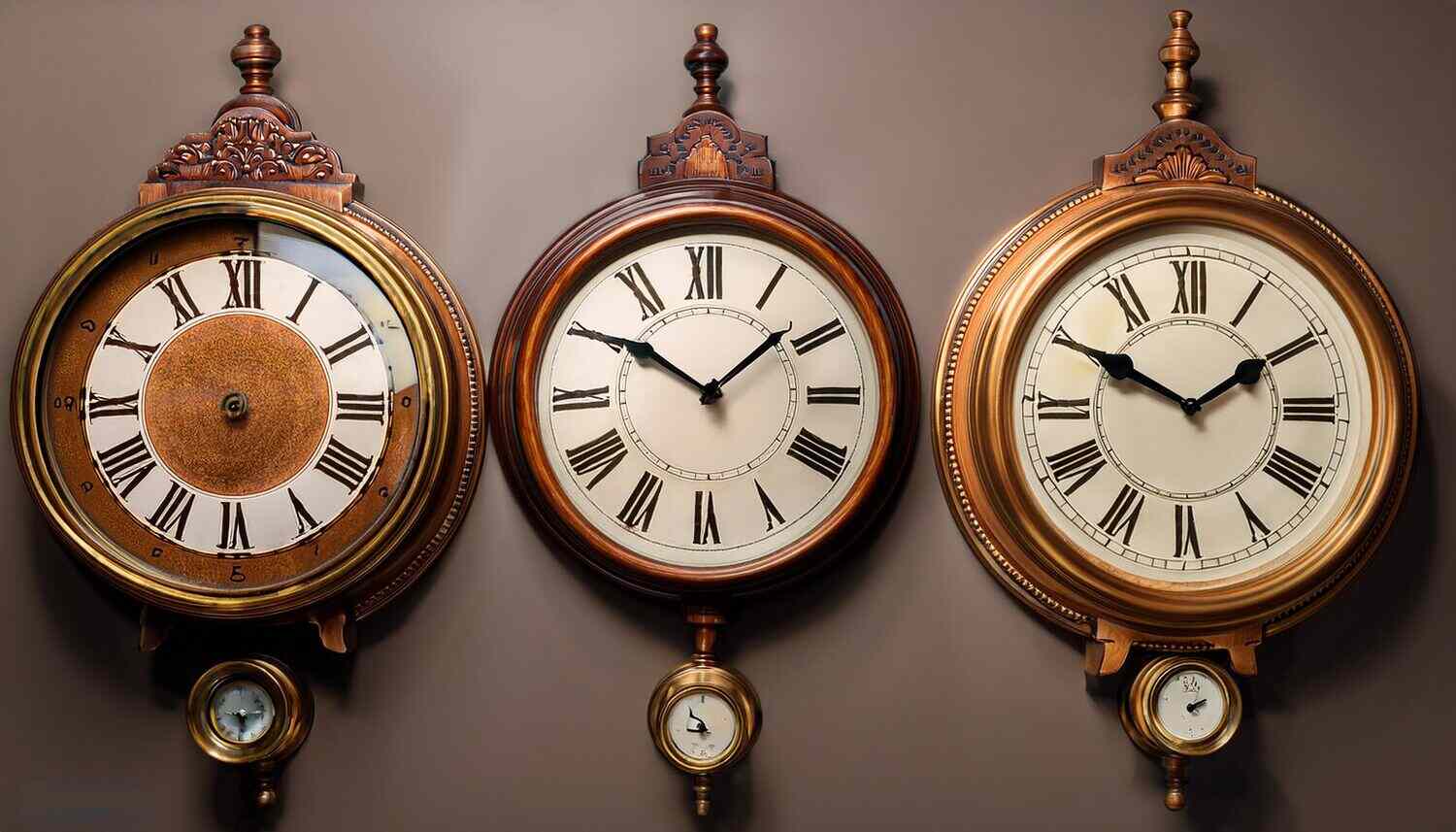
Antique regulator wall clocks with pendulum have the collectors and enthusiasts in awe for a couple of ages. These classic objects are not only the artistic testimony of a bygone era and of the exquisite craftsmanship but they also have a historical value, thus, providing a window into the world of art of the past. Obviously, antique wall clocks with pendulum are timekeepers, but they are also elegant decorative elements that give character and sophistication to any space.
This article delves into the magnificent world of antique pendulum wall clocks, looking into their different types, the intricate craftsmanship behind their making and the factors that decide their value. It also looks into the timeline and progress of these wonderfully made objects, from the designs made of wood in the early days to the more complicated models with keys designed with great precision. Besides that, readers will learn how to decorate modern spaces with these traditional clocks so that they can enjoy the timeless beauty of antique wall regulator clocks with pendulums in their own homes.
The Different Types of Antique Wall Clocks
The antique clock walls are available in different kinds and styles and each type has its own distinctive features and characteristics. These classic artifacts have attracted the attention of collectors and connoisseurs for a long time, as they represent rare craftsmanship and have historical relevance. Let’s explore some popular types of antique regulator wall clocks with pendulum, antique wooden wall clocks with pendulum, and those of key-wound mechanisms.
Antique Regulator Wall Clocks with Pendulum
Antique regulator wall clocks with pendulum are precise and accurate and hence they have gained a huge following over the years. These clocks usually make use of a big move around the clock face that is driven by a long, swinging pendulum to enable them to maintain an almost perfect synchronization with the time 1. They usually have a very unique, quite formal look and were mostly seen in business premises such as banks and offices.
Regulators clocks, the most precise type of pendulum clocks, were created in the mid-18th century as part of the quest for greater timekeeping accuracy. Their main problem of transmitting weight-driven devices was solved by introducing a deadbeat escapement which was a more sophisticated version of the anchor design. One of the ways they did this was to omit calendars, which are often complex features, and instead, use simple mechanisms. Each of the clock’s hands differed, though, as they were all worked off different generators.
A Vienna regulator wall clock’s fame for accuracy led to it being used in places like train stations and post offices regularly. These clocks were made in different periods and each time had a different style and features. Take, for instance, the Empire period (1800-1835) in Vienna, when wood cases were commonly used, either polished or gilded, and made to look like three stacked boxes.
Antique Wooden Wall Clocks with Pendulum
Antique wooden wall clocks with pendulum are yet another type of antique wall clock that is in high demand. These timepieces come in a wooden case that can either be ornately carved or simply designed and most of the time, they have a pendulum that facilitates the accurate timekeeping. Antique wooden wall clocks with pendulum were used in homes more than often and they even got passed down from one generation to another.
In Vienna’s Biedermeier period (1835-1848), wooden pendulum clocks adopted a more conservative style, reflecting the sociopolitical environment of the time. The clocks known as “dachluhr” from this period were of a simpler design. They were composed of two sections: one on top for the clock’s face and movement and the other below for the weights and pendulum accessible through a glass door.
As the middle class in Vienna grew after the revolutions of 1848, the regulator clocks became more affordable for a larger segment of the people. This has thus given rise to the restoration of different styles besides the classical ones such as Greek, Renaissance, and the Gothic styles. The clocks got more and more elaborately shaped, and instead of straight sides, they started to have serpentine waves and to have more finials, columns, and woodwork designs.
Antique Pendulum Wall Clock with Key
Antique pendulum wall clock with key are another type of antique regulator wall clocks with pendulum that was popular in the past. These clocks have a pendulum owned by a key that winds the pendulum helping the clock to run. They are typically decorated in a more intricate, traditional style and were widely used in the affluent households.
To wind the clocks, one usually would put the key into the winding point and rotate it 16 times in a clockwise direction. When the clock is completely wound, an internal mechanism blocks further winding . Now, it is very crucial that you know that although keys can sometimes be used to verify the brand of a watch, it should not be solely relied on for watch identification, as there are many replacement keys that are in circulation.
The development of old wall clocks not only indicates the progress of timekeeping technology but also the shifts in societal inclinations and economic situations. The various types of antique wall clocks from the precision regulator clocks to the wooden ones, and the key-wound mechanisms all tell a story of their time period, making antique regulator wall clocks with pendulum such intriguing pieces for collectors and history enthusiasts.
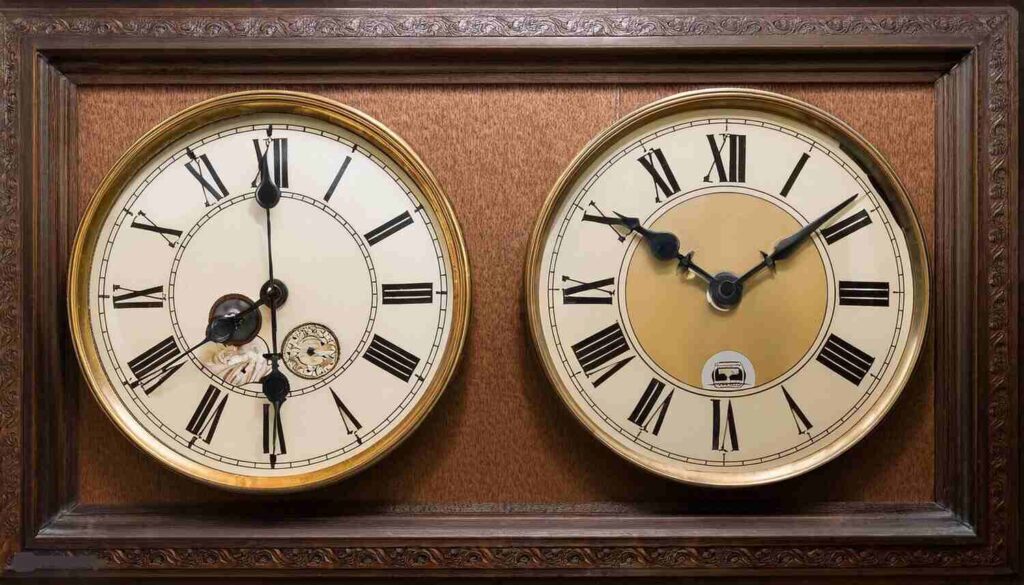
The Craftsmanship Behind Antique Clocks
Horology, or clockmaking as it is called, has gone through a lot of changes throughout history, but very skillful craftsmen have been making time devices that are both functional and aesthetically pleasing. This art integrates the principles of physics, engineering, and design to build clockwork devices that amaze and inspire.
The Art of Clockmaking
Horology’s roots can be linked to ancient cultures, and the earliest timekeeping devices like sundials and water clocks were invented then. As science advances, the first mechanical clocks appeared in the medieval period. These immovable movies, typical in churches, were driven by weights and used the verge-and-foliot escapement to tell the time.
Through the course of time, horologists have learned, on the one hand, to make ever more precise and complex timepieces and, on the other hand, to invent new methods and techniques of their manufacture. Huygens’s 17th-century invention of the antique wall clocks with pendulum changed the world of horology to the point of revolution and brought an accuracy of timekeeping that had not existed before.
Essential components of clock mechanism consist of:
- Movement: The internal mechanism that powers a clock, ranging from simple spring-driven movements to complex mechanical systems.
- Escapement: The device that controls the release of energy from the movement, ensuring a clock keeps time accurately.
- Complications: These are other functionalities of a timepiece like calendar, moon phase display, or stopwatch function.
- Design: The esthetic elements of a clock, including its case, dial, and hands, which showcase the clockmaker’s artistry and creativity.
Materials Used in Antique Clocks
Antique clocks are not just mechanical timekeepers but also masterpieces—the clockmakers are those who are really featured in this work . The use of different materials results in the high durability and esthetic appeal of the clock.
Ever since the ancient times, antique clocks have been made of wood, which adds a rustic and yet classy touch to the entire room. . There is also a variety of timber, each with the quality ranging from the lowest to the highest and the different kinds of wood were used:
- Oak: A heavy and tough material oak is known for its resistance to moisture, shrinkage, fungi, and insects. It usually has a straight-grained appearance and comes in a color range of beige to brown.
- Black Walnut: This tough hardwood is decay-resistant but prone to insect attack. Its color is ranged from light to dark chocolate brown, with the sapwood being the lighter one. Interestingly, black walnut wood becomes lighter over time.
- Maple: Maple is light in color, it is a creamy type and has a fine straight line pattern on it. Hard maple is very strong and doesn’t bend or split, which is why it is preferred in making clocks.
- Cherry: This is not only a medium-density hardwood but also a medium-density hardwood which is usually preferred because of its unique color and smooth texture. The wood is easy to mold, and it gets darker over time, so it starts as yellowish and ends with light reddish-brown.
Materials choice as well as the craftsmanship behind the making of these timepieces are elements that result in their lasting attractiveness and value as functional objects and as works of art.
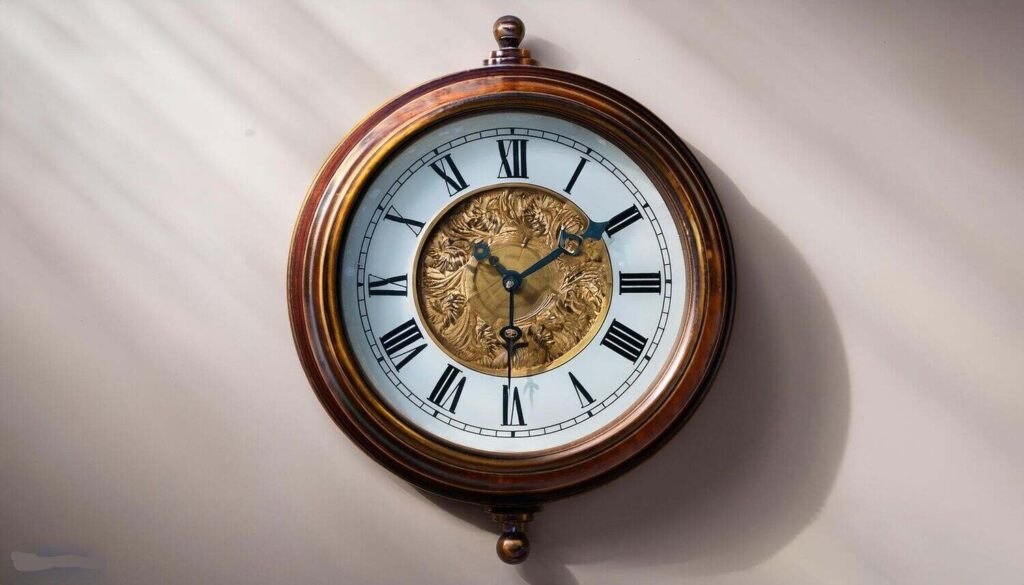
Collecting and Valuing Antique Regulator Wall Clocks with Pendulum
Why Collect Antique Clocks?
Antique pendulum wall clock collecting has become a trend for many lovers of it. They are not just functional instruments for keeping time but also splendid examples of craftsmanship, pieces of history, and a reflection of cultural virtues. The historical background of this clock is what keeps collectors intrigued, as these clocks were often made in accordance with the evolution of technology and the artistic approach of a particular period of time. For example, the Vienna Regulator clock is a highly desirable piece, not just for its quality but also for its exceptional precision.
Determining the Value of an Antique Regulator Wall Clocks with Pendulum
A lot of things count in the prices of antique regulator wall clocks with pendulum:
- Condition: Clocks in good shape enjoy more demand and hence their prices also go up . The outer surface as well as the movement should be in great condition.
- Restoration: The Market generally favors original and unrestored clocks over restored ones for the higher price of originality .
- Maker’s Marks: The more valuable clocks usually have real trademarks or insignias of the clockmaker.
- Provenance: The rich history of a clock belonging to a well-known collection can sometimes add tremendous rank to its price. To illustrate, the Breguet Sympathique clock once owned by the Duke d’Orleans is a record auction price .
- Materials and Craftsmanship: Grouped craftsmanship and barely noticeable defects are more likely to be accompanied by the more expensive price for the piece .
How to Authenticate Antique Clocks
Authenticating antique clocks requires careful examination:
- Examine the Dial: Check for a manufacturer’s name or a mark.
- Check the Case: Look for the writing marks, labels, or trade marks.
- Inspect the Movement: Identify if the dates, trademarks, or patent numbers can be found it.
- Analyze the Pendulum: The latter can confirm the authenticity of a brand but it is not advisable to use it as a confirmation because pendulums can easily be swapped.
- Consider the Key: Before using it as the only means of identification, brand keys can be useful in confirming a manufacturer’s identity but they should not be the only method used.
Caring for and Maintaining Antique Clocks
Proper care ensures the longevity of antique regulator wall clocks with pendulum:
- Regular Winding: An 8-day clock should be wound weekly and a 30-hour clock should be wound daily.
- Avoid Overexposure: The clocks should not be exposed to radiators, direct sunlight, and areas with changing temperatures and humidity.
- Careful Handling: Take care of the pendulum, and take off the weights when transporting the clock.
- Proper Cleaning: The method of cleaning different clock materials is also different.
- Professional Servicing: Schedule the lubrication of the clock every few years and the complete servicing every ten years.
By dealing with these issues of collecting, pricing, authenticating, and preserving antique regulator wall clocks with pendulum, enthusiasts will get more insight into the history of these clock makers, as well as the aesthetic and technical evolution of antique wall clocks with pendulum.
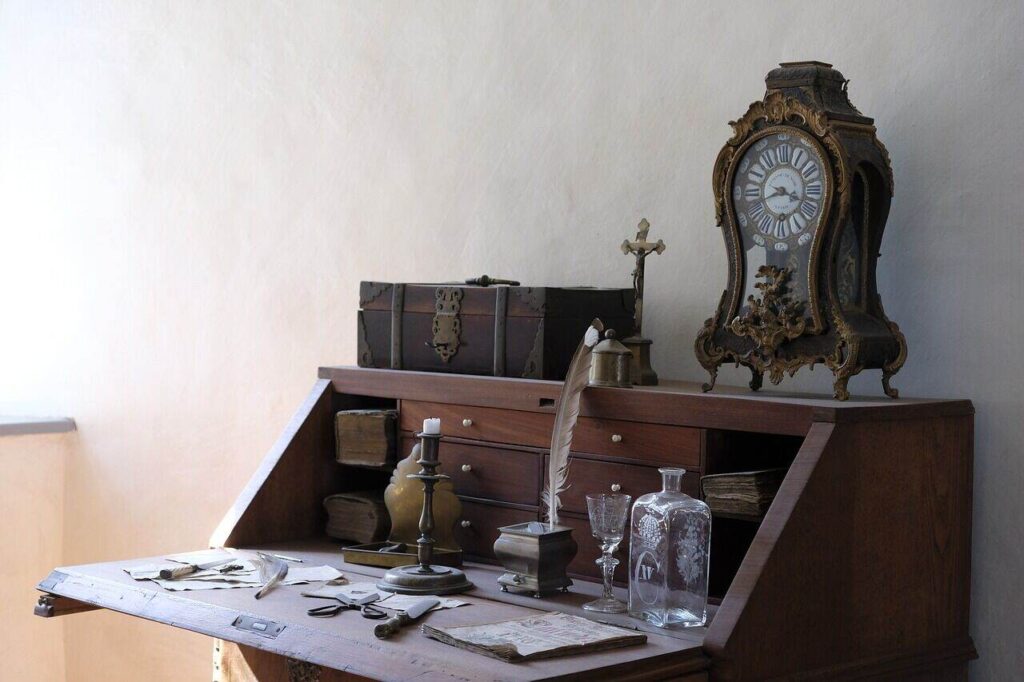
The History and Evolution of Antique Wall Clocks with Pendulum
The Invention of the Pendulum Clock
The antique wall clocks with pendulum story can be traced back to the year 16th century when Galileo Galilei discovered the isochronism of the pendulum in 1583. This discovery was a crucial moment in the development of timekeeping, moving from mechanical clocks that did not perform periodic motion to machines that were moved by continuous oscillation in a fixed cycle. Even though Galileo had the idea of an isochronous pendulum clock in 1637, he never finished it.
It wasn’t until 1656 when Christiaan Huygens made the first antique wall clocks with pendulum that the idea came to fruition, fourteen years after Galileo’s death. Huygens made a pendulum which was used as a weight in the clock with a crown wheel escapement, the compensators were placed on both sides to limit the pendulum’s amplitude. This invention turned out to be a major breakthrough in the accuracy of clocks which range from 15 minutes to 15 seconds per day.
Significant Eras in Pendulum Clock History
The antique wall clocks with pendulum advancement was marked by several important moments:
- 1670: The anchor escapement was invented, probably by William Clement, decreasing the swing angle of the pendulum to a range of 4°-6°.
- 1721: A mercury pendulum for temperature compensation, was devised by George Graham.
- 1726: John Harrison came up with the gridiron pendulum, one more method for temperature compensation.
- 1895: The invention of invar, an alloy with minimal expansion, virtually eliminated the need for earlier temperature compensation inventions.
Famous Makers of Antique Regulator Wall Clocks with Pendulum
Over time, a lot of expert clockmakers have worked on ever more and more antique wall clocks with pendulum:
- Eli Terry (1772-1852): A trailblazer in mass-manufacturing clocks in America.
- Seth Thomas (1785-1859): Made the first wooden movement tall clocks and gradually introduced the most popular shelf movement antique wooden wall clocks with pendulum.
- The Ingraham Clock Company (1828-1978): Famous for their eight-day wooden pendulum wall and mantle clocks.
- Ansonia Clock Company (1850-1929): Featured an assortment of upscale novelty clocks that included mantle, wall, and grandfather clocks.
All of these clockmakers and countless others were major contributors to the perfection and dissemination of antique wall clocks with pendulum, which is one of the reasons the antique wall clocks with pendulum is still so liked and important in the history of horology.
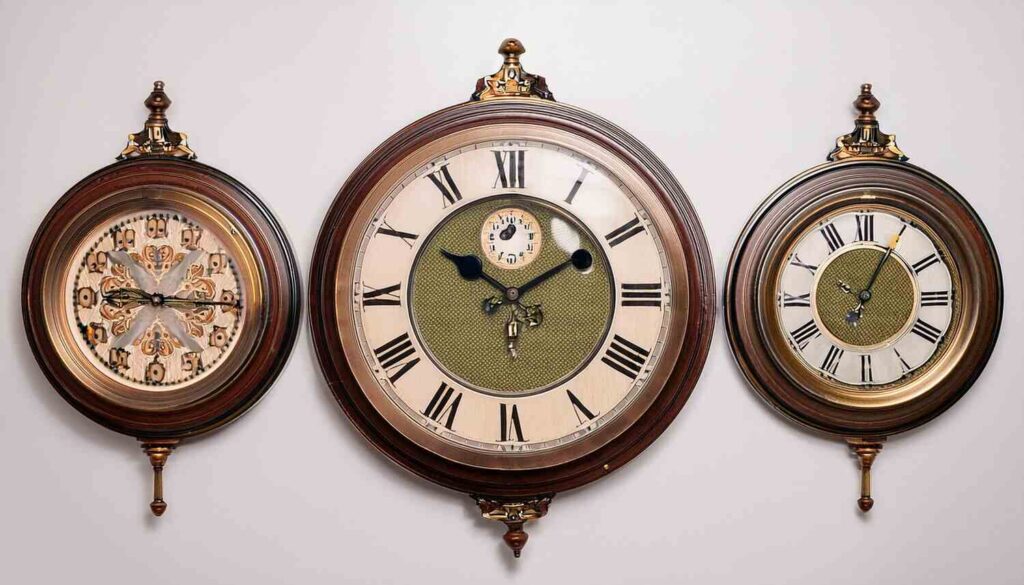
Decorating with Antique Clocks
Incorporating Antique Clocks into Modern Decor
Antique clocks can be a great way to add a touch of nostalgia and personality to your space, as they combine the historical beauty of the past with the modern design of today. These remarkable objects are not just timepieces but also creative deities, lifting the mood of an entire venue. The key to successfully incorporating antique clocks into modern decor is to find the middle ground between the two. Collectors are often fans of the distinctive things and the art of making that are in antique clocks, which are not the case with the modern types that are mostly made of resin.
Where to Place Antique Clocks in Your Home
The artistic provision of these old-style wall clocks gives them the opportunity to be not only the perfectly functional pieces of time measurement but also to become the breath-stopping focal points of your home. Thus, place a clock in a noticeable spot like a fireplace mantel or a console table in an entryway. The kitchen is also a place where you can hang up a vintage wall clock and get the feeling of a bygone era. Alternatively, for a dramatically theatrical effect, place the longcase clock in an airy space such as a foyer or sitting room.
Enhancing the Value of Your Home with Antique Clocks
The antique clock market is quite unstable as it may go up and down, but it will clearly add value and style to your house. The high-end clocks seem to have a good resale value, especially when they are in good condition or made by famous makers. When buying antique clocks for your house, think about factors like the maker’s name, the condition of the clock, and its importance in history. You can achieve the desired aesthetic effect of sophistication and individuality in your home by mindfully integrating these ageless designs into your decor.
Conclusion
Antique regulator wall clocks with pendulum bring a high quality luxury to the home, as well as symbolizing the blending of two worlds, the past with its historical significance and the present with its exquisite craftsmanship, thus, these clocks have become the very definition of timelessness. These magnificent clocks present the viewer with not only the time; they influence the whole atmosphere of the space by becoming the center of attention in the decor which gives an extra note of personality and class to the interior. With their inception in the 17th century to their growth through different eras, these clocks possess a thrilling narrative that captivates not only collectors but also enthusiasts of all kinds.
The timelessness of antique regulator wall clocks with pendulum is because they have both an esthetic value and a link to the past. Be it a Vienna regulator clock that is known for its accuracy and precision or a wooden clock with drug carving, one can say that every piece is telling a story uniquely. Home décor has become a lot more interesting with the introduction of timeless pieces of furniture, but at the same time, we have become more responsible for preserving a piece of horological history for future generations to appreciate and admire.

Leave a Reply